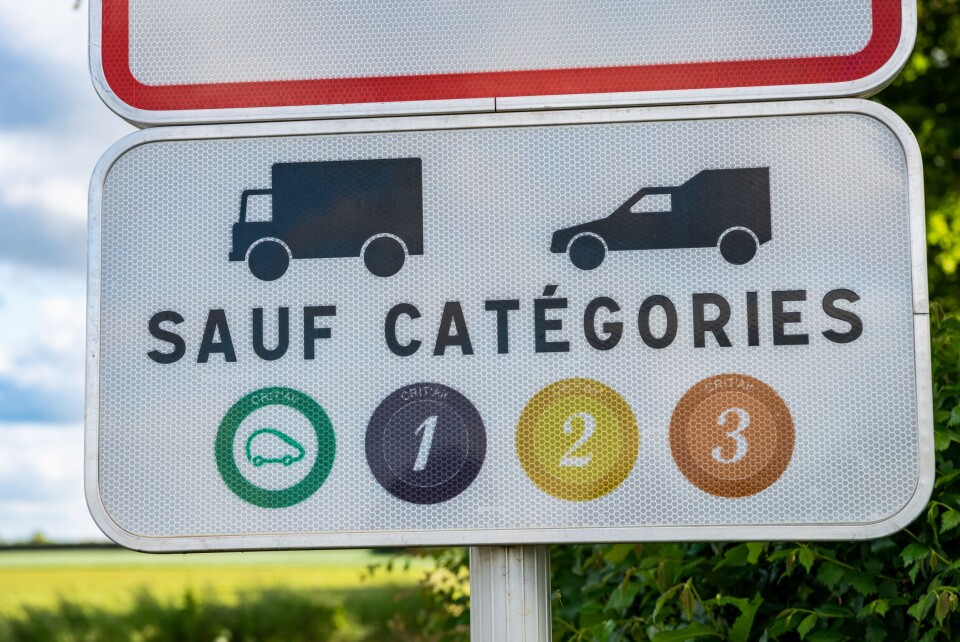-
"Farmer protests to continue despite France opposing Mercosur trade deal"
French opposition to free-trade deal is unlikely to swing scales on key vote
-
UK-EU talks raise hopes of easing post-Brexit rules for Britons in France
Several proposals and plans could ease some post-Brexit complications
-
French study claims ‘Dry January’ participation improves sleep and health
First major study of its kind in France praises challenge, but alcohol-free month is yet to receive official endorsement
Delay rollout of more low-emission zones in French cities says senator
There are meant to be 43 zones across France by 2025. But some think the deadline is too tight

A report from France’s Senate has called into question the country’s controversial low-emission zones.
Currently in 12 locations across France - including Paris, Lyon, Nice Toulouse and most recently Toulon - they are designed to improve air quality by restricting which vehicles can circulate.
But all towns or cities with a population of more than 150,000 are required to introduce one by 2025, bringing the total number to 43.
The Senate report, however, has called for a more “flexible” timeline for the introduction of zones à faibles émissions mobilité (ZFE) to help with wider acceptance of the controversial measure.
It also suggested an increase in government subsidies to help with the purchase of ‘clean vehicles’ (that would not be subject to restrictions in ZFEs).
Senator Philippe Tabarot, of the right-wing Les Républicains party, who prepared the report, said the government is not providing sufficient support, that the range of alternatives to the car is "too modest" and that clean vehicles are "financially inaccessible".
Read also: Where in France must drivers now display a Crit’Air pollution sticker?
2030 cut-off date proposed
Current rules state all 43 urban areas required to implement a ZFE will have to do so by January 1, 2025.
Although this does not mean an immediate end to polluting vehicles in these areas – rules are different for each ZFE, and only the most polluting vehicles are currently being targeted – it is a tight deadline for both authorities and drivers.
The Senate report proposes extending the final deadline for implementing zones in these areas to January 1, 2030, believing the current deadlines are “too close together” to be effective.
Prolonging the deadline is “essential to give [urban areas] more room for manoeuvre by making the current timetables more flexible,” said Mr Tabarot.
Increasing the deadline “would leave [urban areas] the option of using alternative solutions that are more efficient and faster,” he added.
Read also: France driving: What must residents and visitors carry in their cars?
Hasty change could ‘widen societal divide’
The senator also highlighted the economic impact of making the changes so soon.
“Banning more than a third of the vehicles that pass through our biggest cities every day… within a year and a half, will inevitably widen the social and territorial divide," he said, citing the 13 million cars, trucks, and motorcycles that could be prevented from entering these areas in the next 18 months.
The mass conversion to low-polluting vehicles “in such a tight timescale… is materially difficult to envisage, given their cost,” added the senator.
To combat this, further financial help for purchasing greener vehicles should be provided, especially to lower-income households, and a dedicated government portal to help with acquiring subsidies and purchasing vehicles should be set up.
Alternative methods of transport, including public transport systems, are an “essential” prerequisite to the success of ZFEs, the report adds.
Proponents of the scheme say it is necessary, however, to lower emissions in the country from vehicles.
The focus of ZFEs in built-up urban areas is also aimed at improving the health of city residents, by reducing pollution.
Some cities, like Reims, have implemented strict regulations on cars in their ZFE in a bid to quicken the area’s ecological transition.
Read also: Low-emission zones are a bad idea, say French greens
What impact do ZFEs have?
Any vehicle driving through a low-emission zone is required to display a Crit’Air sticker, showing how polluting the vehicle is.
The stickers range across six levels, with level 4 and 5 vehicles being the most polluting, and the target of most restrictions.
Some ZFEs limit the times when these vehicles can enter cities, and some ban them entirely.
The plan is for all polluting cars to eventually be banned from these zones, via a series of progressively stricter rules.
Paris was originally set to ban cars with a level 3 Crit’Air sticker from the city between 08:00 and 20:00 this year but has pushed this back until 2024, possibly until after the city hosts 2024’s Olympic Games.
You can read our explainer about Crit’Air stickers and ZFE zones here.
Related articles
Crit’Air: Older cars in Toulouse can bypass rules with attestation
























